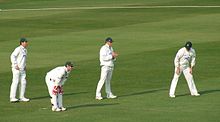
Fielding in the sport of cricket is the action of fielders in collecting the ball after it is struck by the striking batter, to limit the number of runs that the striker scores and/or to get a batter out by either catching a hit ball before it bounces, or by running out either batter before they can complete their current run. There are a number of recognised fielding positions and they can be categorised into the offside and leg side of the field. Fielding also involves trying to prevent the ball from making a boundary where four "runs" are awarded for reaching the perimeter and six for crossing it without touching the grass.
A fielder may field the ball with any part of their body. However, if, while the ball is in play, he/she wilfully fields it otherwise (e.g. by using their hat) the ball becomes dead and five penalty runs are awarded to the batting side, unless the ball previously struck a batter not attempting to hit or avoid the ball. Most of the rules covering fielders are set out in Law 28 of the Laws of cricket. Fake fielding is the action when a fielder makes bodily movements to feign fielding to fool batters into making mistakes and is a punishable offence under the ICC rules.[1]
- ^ "Men's ODI Match Clause 41: Unfair Play". www.icc-cricket.com. Retrieved 21 December 2019.